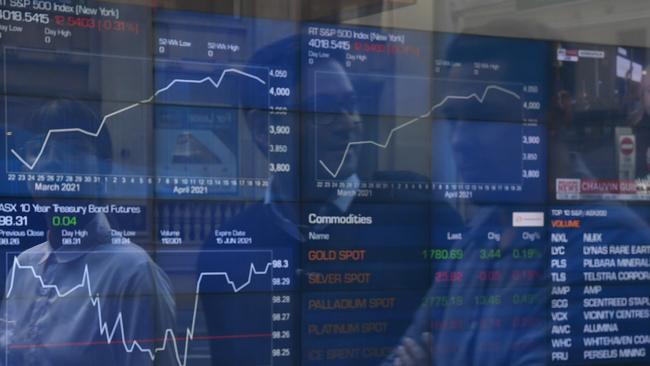
The S&P/ASX 200 index closed down 20.4 points, or 0.3 per cent, at an intraday high of 6997.4 points after tumbling 1.6 per cent to a two-week low of 6905.4 in response to steep offshore falls.
The impressive bounce came as the nation’s COVID numbers remained under control even as the situation worsened overseas.
Defensive growth stocks were favoured with CSL up 1.5 per cent, Wesfarmers up 0.7 per cent and Cochlear up 1.5 per cent, but the major banks and iron ore miners staged big intraday rebounds.
“The market is taking a cautious stance at the moment as we saw the vaccine winners and re-opening stocks all hammered on COVID concerns with spikes in numbers occurring in India and Tokyo,” said Bell Potter’s head of institutional sales and trading, Richard Coppleson. “These issues have been around for a while … the market was looking for an excuse to sell off.”
World Health Organisation director-general Tedros Adhanom Ghebreyesus warned last week that new cases of COVID per week had almost doubled in the past two months to be near the highest level so far during the pandemic. In Japan, Tokyo and Osaka asked for fresh lockdowns on Wednesday.
Japan’s sharemarket dropped another 2 per cent after falling the same amount a day earlier.
UK and European benchmarks dropped by similar amounts on Tuesday.
On Wall Street, the S&P 500 index had its biggest two-day fall in the past four weeks with a loss of 1.2 per cent after it hit a record high of 4191.31 on Friday.
The US State Department said it was preparing to advise Americans against travelling to 80 per cent of countries because of the state of the pandemic, saying that COVID continued to “pose unprecedented risks to travellers”, adding that the decision to update its travel advice “does not imply a reassessment of the current health situation in a given country”.
Mr Coppleson said the dip in Australian shares was “welcomed” by many institutional investors, who had been holding back not wanting to “chase” the market, and a leading equity strategist cautioned that the local bourse had become overvalued.
With the ASX 200 trading on an estimated 12-month forward price-to-earnings multiple of 18.5 times, its “valuation looks stretched by the standards of the past decade”, while on a “through the cycle” earnings basis, its PE ratio of about 28 times was also stretched, albeit nowhere near its 2007 peak level of 38.4 times, according to Credit Suisse Australia equity strategist Damien Boey.
Mr Boey also said Australian equities looked expensive relative to bonds on a five-year horizon.
“This is not a great starting point, but it does not have to be the harbinger of ‘doom and gloom’ for investors either,” he said. “Key factors which could still save the outlook for equities include the earnings cycle, and the possibility that bond yields fall.
“We think that bonds are likely to remain volatile for a while longer on inflation, tapering and tightening concerns (and) ultimately, we think that bond yields are more likely to be lower than higher over the next year given meaningfully positive term risk premia on offer.”
In his view, there’s “more upside” to the earnings of global exposures linked to the global industrial production cycle than there is to domestic exposures linked to local economic growth.
“We also think it wise to maintain a quality overlay given risks of multiple compression in a volatile yield environment,” Mr Boey added. “Interestingly, large iron ore miners screen well on all of these fronts, noting the strength of cashflows and balance sheets.”
The bounce in Australian shares also came as investors awaited reports from major banks. Macquarie analyst Victor German said favourable trading conditions for banks gave “upside risk”.
With March quarter trading incomes for US investment banks up about 14 per cent on a year-on-year basis, Mr German increased his earnings forecasts for Australian banks by up to 2 per cent for 2020-21, with ANZ the biggest beneficiary since it has relatively greater exposure to markets income.
Trading conditions were favourable in the first quarter of 2021, with fixed-income, currencies and commodities revenues for US banks beating the consensus estimate by a combined 20 per cent.
While noting that Australian banks’ trading income differs from the US banks with a bigger proportion of revenue coming from rates and FX, he said recent trends from US investment banks suggested further upside risk for markets income in the first half.






A shares rollercoaster ride saw the local bourse stage a remarkable rebound after a sharp sell-off in response to renewed jitters in global markets over the pandemic.